Japanese carotenoid database with α- and β-carotene, β-cryptoxanthin, lutein, zeaxanthin, lycopene, and fucoxanthin and intake in adult women
Abstract
Abstract. Carotenoid intake is associated with low mortality and cancer risks; data on non-provitamin carotenoid intake is limited especially in Asians. We aimed to estimate carotenoid intake in Japanese adult women. Carotenoid content database comprises 196 food items, including 39 fruits, 87 vegetables and mushrooms, and 11 seaweeds, and was established using data from the literature and analyses of foods available in Japan. We surveyed the intake of these foods in Japanese women aged 21–56 years (n=109). Total intake of 7 carotenoids (mean±SD [range]) was 7,450±3,840 (1,160–21,300) μg/day; α-carotene, β-carotene, β-cryptoxanthin, lutein, zeaxanthin, lycopene, and fucoxanthin represented 4.3%, 23%, 3.4%, 15%, 2.0%, 39%, and 13% of total intake, respectively. Lutein intake was 1,132±686 (294–3,490) μg/day; its best sources were spinach, cucumber, chicken egg, green onion, and Chinese chives, representing 51% of total intake. Lutein can be obtained from a variety of sources. Thus, lutein intake levels did not vary widely among individuals and very few individuals consumed insufficient levels of lutein. Intake of zeaxanthin, lycopene, and fucoxanthin was 149±93 (2–479), 2,890±2,970 (0–17,100), and 980±1,230 (0–5,660) μg/day, respectively. Their intake required rich sources including chicken egg for zeaxanthin (52%); tomato products for lycopene (98%), and wakame seaweed for fucoxanthin (76%). The carotenoid content database including all food items consumed in Japan will be helpful for further investigations on carotenoid intake and its health benefits.
Introduction
Observational studies have shown that regular consumption of fruits and vegetables is associated with low risk of total mortality, cardiovascular diseases (CVDs) including stroke, colon cancer [1–3], metabolic syndrome [4], and hypertension [5]. Fruits and vegetables contain nutrients, such as vitamins, minerals, and dietary fibres, and non-nutrient phytochemicals, such as polyphenols and carotenoids, that are thought to exert health benefits. Carotenoids are lipophilic pigments with antioxidant properties; are synthesised by all plants and many microorganisms; and should be obtained through diet. It has been reported that total carotenoid intake, particularly from fruits and vegetables, is associated with a low risk of total mortality [6, 7], and its blood concentration is associated with low risks of some cancers, including lung cancer [8], and metabolic syndrome [9]. α- and β-carotene alone also showed similar health benefits noted in observational studies [7–9].
Non-provitamin A carotenoids, such as lycopene, lutein, and zeaxanthin, have also been reported to be associated with low risks of some diseases. Lycopene may lower the risks of total mortality and some cancers including lung, colorectal, and prostate cancers [7, 8, 10–12]. Lutein and zeaxanthin protect the retina [13] and are assumed to lower the risk of age-related macular degeneration and cataract [14, 15]. Lutein and lycopene are also associated with low risk of CVDs [16, 17].
There is no published database on non-provitamin carotenoid content of food in Japan, and information on the overall intake of carotenoids is limited. Therefore, a carotenoid content database and estimating carotenoid intake are important to further understand the health benefits of carotenoids for eye health and lowering the risk of non-communicable diseases. A carotenoid content database that includes information on α- and β-carotene, β-cryptoxanthin, lycopene, lutein, and zeaxanthin has been established in US and Europe [18, 19] and is used for intake surveys [20, 21] and epidemiological studies investigating the association between carotenoid intake and risk of disease. However, the food items and carotenoid contents differ between regions, and information is limited in Asian populations, which consume vegetables different from those consumed by Westerners, such as mustard spinach, onion leaf, potherb mustard leaf, and seaweeds. For example, seaweed, which is a typical component of Asian diet, is rich in fucoxanthin, possibly making it a common carotenoid consumed in Asia; however, no study has reported its intake. A recent prospective study in Japan showed that seaweed intake is inversely associated with the risk of ischemic heart disease [22].
Life expectancy among the Japanese is the highest worldwide [23], and the health benefits of the Japanese diet has gained increasing attention as it has been hypothesised to be associated with low risks of all-cause and CVD mortality, dementia, functional disability, and disability-free survival time [24–27]. This study aimed to create a carotenoid content database, including α- and β-carotene, β-cryptoxanthin, lutein, zeaxanthin, lycopene, and fucoxanthin, based on food items consumed in Japan, and to estimate the daily intake of carotenoids in Japanese adult women, using the food and beverage consumption survey.
Materials and methods
Survey for food and beverage consumption
The survey was conducted in 2010 originally for estimating total polyphenol intake described in a previous report [28]. Briefly, 109 adult women aged 21–56 years living around Tokyo were randomly recruited from 20,000 candidate monitors pre-agreed with door-to-door examiners and were included after agreeing to participate in this survey. The profiles of all participants are shown in Table 1. The participants recorded all beverages and food materials consumed and the cooking menus for 7 days. Consumption of foods and energy intake was estimated using the nutrition calculation software EXCEL EIYO-KUN (ver. 5.0, Kenpakusha, Tokyo), which provides information on portion size and weights of food materials for a cooking menu [29].
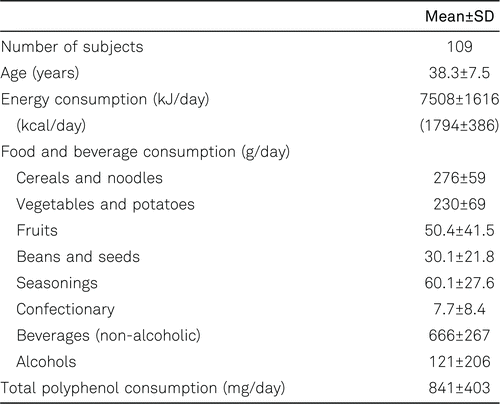
Carotenoid content database
The carotenoid content database, composed of 7 carotenoids, α-carotene, β-carotene, β-cryptoxanthin, lutein, zeaxanthin, lycopene, and fucoxanthin, was created based on all food items that appeared in the survey and those previously reported to potentially contain carotenoids. The carotenoid content of each listed food item was determined using the existing references described below or were measured when data were lacking or as necessary for confirmation. Contents of α-carotene, β-carotene, and β-cryptoxanthin were referred from the Standards Tables of Food Composition in Japan 2015 (Seventh Revised Version) [30]. Contents of lutein, zeaxanthin, and lycopene were referred from the data on fruit and vegetables in Japan described in Aizawa and Inakuma [31] and Yano et al. [32]. Contents of the fucoxanthin were referred from Terasaki et al. [33]. We additionally measured contents of lutein, zeaxanthin, lycopene, and fucoxanthin from 19 food items, including eggs, tomato, vegetable juices, and dried seaweeds, where they were lacking in some food and beverage items referring from the US Department of Agriculture (USDA) carotenoid database [18] and our survey described below. Finally, the carotenoid content database for Japanese diet was established and 196 food items including 39 fruits; 87 vegetables and mushrooms; 11 seaweeds; 24 beans; potatoes and cereals; and 35 others including animal products, seasonings, and beverages were listed. Contents on α-carotene, β-carotene, β-cryptoxanthin, lutein, zeaxanthin, lycopene, and fucoxanthin from 192, 195, 192, 73, 77, 62, and 8 food items, respectively, were included at the database. All food items with contents data on lutein, zeaxanthin, lycopene, and fucoxanthin, except for matcha and two green juices whose data is limited on β-carotene, lutein and zeaxanthin, have data on vitamin carotenoids, α-carotene, β-carotene, and β-cryptoxanthin.
Quantification of carotenoids
Lutein and zeaxanthin, lycopene, and fucoxanthin were obtained from EXTRASYNTHESE (Genay, France), FUJIFILM Wako Pure Chemical Co. (Osaka, Japan), and CaroteNature (Münsingen, Switzerland), respectively. Food samples used for measurement in this study were purchased from local Japanese markets in Tokyo and Kobe, which were harvested from famous production areas in a few seasons. Carotenoid contents of the edible portions were measured using a previously described procedure [31], with slight modifications. Briefly, 5 g samples were homogenized in water, extracted with HEAT solvent, hexane: ethanol: acetone: toluene (10:7:6:7), saponified with methanolic KOH, then pigments were extracted with HEAT solvent and evaporated. The high-performance liquid chromatography (HPLC) system comprised an LC-20AD and SPD-20AV detector (Shimadzu, Kyoto, Japan) with Luna Silica (3 μm, 4.6 mm×150 mm, Phenomenex, USA). Hexane:acetone (82:18) solvent at a flow rate of 1.2 mL/min was used as the mobile phase. Injection volume was 30 μL and column temperature was set at 30 °C. Absorbance at 450 nm was measured, and carotenoids were quantified by determining the peak areas in the HPLC chromatograms, calibrated with standard samples. The range of calibration curve was at 0.014–2.23 μg/mL and r2 value was 0.999. All measurements were performed in duplicates.
Statistical Analysis
The results are presented as mean values±standard deviation (SD) or median (range). Normality of data distribution was tested using the Kolmogorov–Smirnov test. All statistical analyses were performed using IBM® SPSS® Statistics 19 (SPSS Japan Inc., Tokyo, Japan).
Results
Total carotenoids
Carotenoid contents and sources are summarised in Table 2. Tomato (10,180 μg/100 g); carrot (9,600 μg/100 g); green leafy vegetables such as beefsteak plant (26,000 μg/100 g), parsley (17,600 μg/100 g), mustard spinach (10,700 μg/100 g), and spinach (8,800 μg/100 g); and dried foods such as wakame seaweed (152,000 μg/100 g), dried laver (30,000 μg/100 g), and hot pepper (39,000 μg/100 g) were found to have high total carotenoid contents.
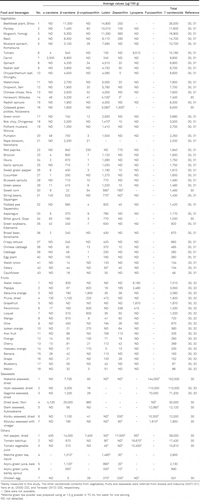
The calculated total carotenoid intake in the Japanese adult women and their sources are shown in Table 3. The mean±SD (range) total daily intake of 7 carotenoids was 7,450±3,840 μg (1,160–21,300 μg). The major sources of total carotenoids were carrot, ketchup, tomato, tomato and vegetable juice, wakame seaweed, spinach, satsuma orange, and chicken egg, accounting for 16%, 15%, 13%, 11%, 11%, 6%, 3%, and 2%, respectively. Meanwhile, α-carotene and β-carotene, β-cryptoxanthin, lutein, zeaxanthin, lycopene, and fucoxanthin accounted for 4.3%, 23%, 3.4%, 15%, 2.0%, 39%, and 13%, respectively, of total carotenoid intake.
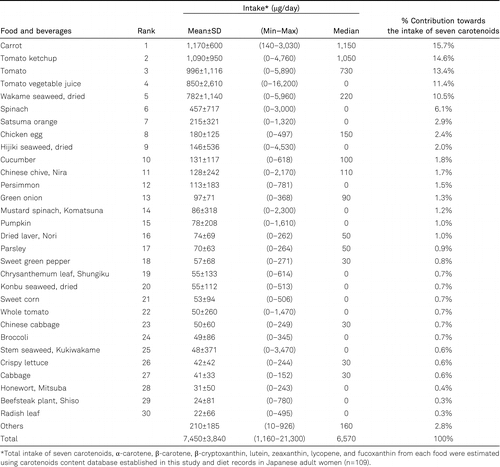
α-Carotene, β-carotene, and β-cryptoxanthin
No food item was rich in all carotenoids, but primarily had high content of one or two carotenoids; carrot was rich in α- and β-carotenes, tomato was rich in lycopene, green leafy vegetables were rich in β-carotene and lutein, and seaweeds were rich in fucoxanthin and β-carotene. We found high α-carotene content in dried laver and carrot at 4,100 and 2,500 μg/100 g, respectively; β-carotene in dried laver, hot pepper, beefsteak plant, wakame seaweed, parsley, and carrot at 25,000, 14,000, 11,000, 7,700, 7,400, and 6,900 μg/100 g, respectively; and β-cryptoxanthin in hot paper and satsuma orange at 7,400 and 1,800 μg/100 g, respectively (Table 2).
Intake of α-carotene, β-carotene, and β-cryptoxanthin is shown in Table 4. The mean±SD (range) daily intake of α-carotene, β-carotene and β-cryptoxanthin was 323±161 μg (36–824 μg), 1,715±727 μg (335–3,490 μg), and 254±304 μg (1–1,460 μg), respectively. In total, 94% of α-carotene was sourced from carrot and 3% was from dried laver. β-carotene was mainly sourced from carrot and spinach at 49% and 13%, respectively. Several vegetables and fruits contributed to β-carotene intake, with the top 10 contributors being carrot, spinach, dried laver, Chinese chives, tomato, tomato ketchup, wakame seaweed, parsley, chrysanthemum leaf, and cucumber, accounting for 82% of its total intake. β-cryptoxanthin was sourced from fruits, such as satsuma orange and persimmon (74% and 17%, respectively).
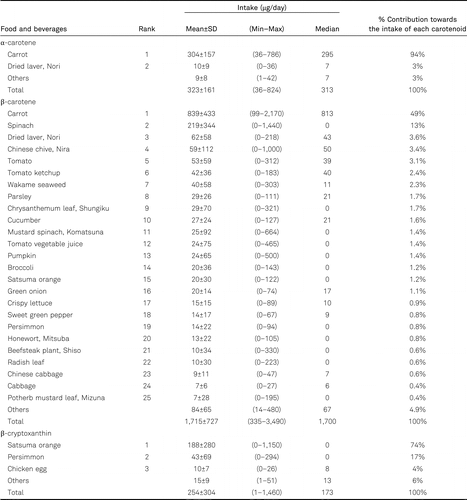
Lutein, zeaxanthin, lycopene, and fucoxanthin
We found high lutein content in green leafy vegetables including beefsteak plant, parsley, mustard spinach, spinach, honewort, and Chinese chives at 14,800, 10,010, 7,590, 4,510, 4,100, and 4,050 μg/100 g, respectively, and zeaxanthin in hot pepper and nozawana, which is a coleslaw of green pickles, at 17,500 and 1,300 μg/100 g, respectively (Table 2). We observed high lycopene content in tomato ketchup, tomato vegetable juice, tomato, and watermelon at 16,670, 10,450, 9,510 and 6,180 μg/100 g, respectively, and fucoxanthin in dried seaweeds such as wakame, hijiki, and konbu at 144,000, 110,000, and 10,300 μg/100 g, respectively (Table 2).
Intakes of lutein, zeaxanthin, lycopene, and fucoxanthin are shown in Table 5. The mean±SD (range) daily lutein intake was at 1,132±686 μg (294–3,490 μg). Spinach was the largest source of lutein; a mean±SD intake of 235±369 μg/day accounted for 21% of lutein intake. Lutein was ubiquitous in several plants, with the top five sources being spinach, cucumber, chicken egg, green onions, and Chinese chives, accounting for 51% of lutein intake. The succeeding next five rich sources were mustard spinach, pumpkin, sweet green pepper, parsley, and Chinese cabbage, and accounted for 20% of lutein intake. Commercially available beverages based on green leaves, such as matcha green tea and aojiru green juice, which is made from kale, were rich in lutein at 1,460 μg and 990 μg per 100 g as consumed, respectively. However, these did not appear in the current survey as consumed food items. Kale is listed in the USDA carotenoid database, but it is rarely available in Japanese markets.
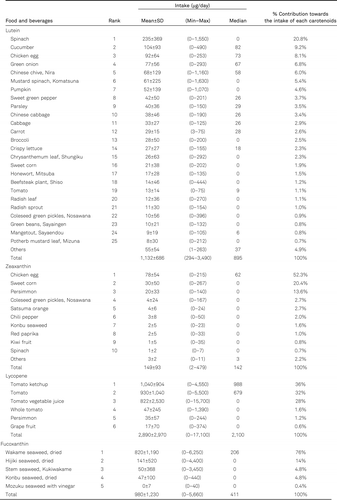
The mean±SD (range) daily intake of zeaxanthin was 149±93 μg (2–479 μg), with chicken egg (230 μg/100 g of zeaxanthin) as its primary source, accounting for 52% of its intake. The mean±SD (range) daily intake of lycopene was 2,890±2,970 μg (0–17,100 μg), and 98% was sourced from tomato products. The mean±SD (range) daily intake of fucoxanthin was 980±1,230 μg (0–5,660 μg), and 76% was sourced from wakame seaweed. The food sources of zeaxanthin, lycopene, and fucoxanthin were relatively limited.
The individual distribution of total intake of seven carotenoids and lutein and zeaxanthin intake are summarised in Figure 1. We found marked individual differences in total carotenoid intake, with a 19-fold difference between the highest and lowest intake levels of total carotenoids. In particular, the difference was larger in lycopene and fucoxanthin, whose dietary sources were limited.

Discussion
This study established a carotenoid content database, which includes not only pro-vitamin A carotenoids such as α-carotene, β-carotene, and β-cryptoxanthin, but also non-pro-vitamin carotenoids such as lutein, zeaxanthin, lycopene, and fucoxanthin, for Japanese diet. The current carotenoid database contains 196 food items, which is larger than that of USDA and European databases, which have 126 and 107 food items, respectively [18, 19]. The number of fruits items was similar among the three databases; however, that of vegetables and beans in our database was mostly double that in the US and European databases. Some popular vegetables in Japan such as beefsteak plant, mustard spinach, chrysanthemum leaf, bok choy, potherb mustard, and seaweeds were not listed at the US and European databases. In contrast, artichoke was included in the European database but was not listed in our database. In terms of types of carotenoids, lutein and zeaxanthin were grouped together as one entity in the USDA database. Fucoxanthin was newly /added as the seventh carotenoid in our database. To our best knowledge, this is the first study in Japan to comprehensively describe the source of carotenoid intake. Food items rich in carotenoids were dominated by one or two major carotenoids, such as α- and β-carotene in carrots, β-cryptoxanthin in orange, β-carotene and lutein in spinach, lycopene in tomato products, lutein and zeaxanthin in chicken eggs, and fucoxanthin in seaweeds. Seaweeds were a major source of carotenoids in the Japanese participants, in which dried laver was the second largest source of α-carotene. Further, dried laver and wakame seaweed were included in the top 10 largest sources of β-carotene. Chicken egg was the largest source of zeaxanthin, accounting for 52% of total zeaxanthin intake, and it was also the third largest source of lutein. This may be attributed to the diet of chickens containing corn, which is the primary source of lutein and zeaxanthin.
Sources of lutein were diversified, and the top five primary food sources accounted for 51% of lutein intake in this study. In contrast, sources of zeaxanthin, lycopene, and fucoxanthin were limited, and the consumption of these compounds through the top 5 most commonly consumed food items were 92%, 99%, and 100%, respectively. Similar to β-carotene, lutein can be obtained through a variety of dietary sources, which may have resulted in low individual differences in its intake and sufficient intake in most individuals. Cucumber was the second largest source of lutein because of its high consumption. The commercially available cucumber in Japan contains lutein at 1,270 μg/100 g; however, the USDA carotenoid database states that the level of lutein is not detectable. Cucumber is a popular vegetable regularly used for salads because of its fresh green colour and crispy texture; however, it is not recognised as a nutritious “green and yellow vegetable” containing at least 600 μg/100 g carotenes defined by the Ministry of Health, Labour and Wellness (Standard Tables of Food Composition in Japan 2015, Seventh Revised Version) [30]. Some major vegetables such as green onion, Chinese chives, mustard spinach, honewort, and seaweeds that result in the high carotenoid intake in the Japanese are not listed in the USDA carotenoid database, thus highlighting the importance of a carotenoid content database with local food items and their analytical value.
Earlier studies reporting on total carotenoid intake were mostly conducted in Western countries, and studies in Asia are limited. In the present study, the average total intake of carotenoids in Japanese women was 7,450 μg (7 carotenoids) and 6,470 μg (6 carotenoids excluding fucoxanthin), which is slightly higher than that reported in previous studies in Japan. Sugiura et al. conducted a Mikkabi cohort study series in an orange farmers’ area in Japan and showed total carotenoid intake from six carotenoids including α- and β-carotene, β-cryptoxanthin, lutein, lycopene, and zeaxanthin at 3,490 and 4,949 μg/day in middle-aged men and women (n=1073, 56±10 y) and 5,600 μg/day in postmenopausal women (n=293, 60±6 y), respectively [34, 35]. The slight differences in the averages may have arisen from regional differences, where the intake of oranges, rich in β-cryptoxanthin, was larger in the previous studies conducted at the orange farmer’s area. Hosotani and Kitagawa reported the total intake of 6 carotenoids at 2,853 μg and lutein+zeaxanthin at 351 μg from 15 green and yellow vegetables in young and middle-aged Japanese [36]. These values were lower than those observed in our study primarily because of differences in food categories, indicating that a carotenoid content database for carotenoid intake estimation should include a wide range of food items comprising not only green and yellow vegetables but also fruits, seaweed, and animal products such as eggs. Lin et al. reported 5,988 μg/day of total carotenoid intake from diet via 4 carotenoids (α- and β-carotene, lutein, and lycopene) in Taiwanese men and women (n=43, 64±6 y) [38]. Our values were very similar to those noted in Taiwan and Spain [37, 38], whereas they were approximately half of those noted in Australia, France, Italy, UK and USA [19, 21, 39, 40], and higher than those reported in Brazil [41]. Studies in France, Taiwan, USA, and UK [19, 37, 40], as well as this study, have a smaller number of subjects than do other population-based studies with more than 1000 subjects, and the intake level may require further confirmation.
Lutein and zeaxanthin are not nutrients; however, these compounds are specifically localised in the retina and are essential in protecting optical cells, and their deficiency is associated with the age-related macular degeneration [13]. Intervention studies show that a supplement containing 10,000 μg lutein and 2,000 μg of zeaxanthin helps to increase macular pigment and improve contrast function [42] and 10,000 μg of lutein may improve cognitive functions in healthy adults [43]. In the present study, the average daily intake of lutein and zeaxanthin in Japanese women was 1,132 μg and 149 μg, respectively, which is lower than the effective dose for supplement. The results of previous studies in Japan on average daily lutein intake were not markedly different from those of our current study. Some studies in Japan reported an average daily lutein intake of 1,380 and 1,920 μg in middle-aged Japanese men and women (n=1073) [34], respectively, 2,060 μg in postmenopausal women (n=293) [35], and 1,570 μg in young men and women (n=11) [44]. Lutein intake alone or lutein and zeaxanthin intake in healthy adults ranged from 700 to 4,000 μg in Australia, Brazil, France, Germany, Italy, Spain, UK, USA, and Taiwan, and lutein intake from regular diet never reached a supplement dose at 10,000 μg [19, 20, 21, 37–41]. Zeaxanthin intake in the Japanese Mikkabi cohort study was 590 μg in men and 700 μg in women [34], which is higher than that in the present study but still lower than that of an effective dose at 2,000 μg, suggesting that although the intake of lutein and zeaxanthin from regular diet is generally lower throughout a lifetime, it is adequate to maintain eye health. The average daily lycopene intake in this study was 2,890 μg, which was much higher than that in another Japanese survey that reported lycopene intake as 50 and 70 μg/day in men and women, respectively [34], suggesting that lycopene intake depending on tomato product consumption was more diversified in Japan. Lycopene intake in Italy, Australia, and USA was more than two-fold higher than that observed in the present study [21, 39, 40]. This study is the first to show fucoxanthin intake, which was at an average of 980 μg/day, in Japanese women. Fucoxanthin intake ranked as the fourth major carotenoid following lycopene, α-carotene, and lutein, and accounted for 13% of the total carotenoid intake.
This study has some limitations. First, our survey recorded the cooking menu and food items, which were not weighed but estimated using a representative menu. This may have caused over and underestimation of the food consumption. Second, we estimated total carotenoid intake using seven carotenoids and did not estimate the intake of astaxanthin, which is expected to be consumed by the Japanese from salmon and salmon egg, because our dietary records, originally designed for estimating polyphenol intake, lacked detailed information on the types of fish and seafoods consumed in Japan. Neoxanthin, violaxanthin, phytoene, and phytofluene, which are widely present in fruits and vegetables [45], were not included in our database. Total carotenoid intake could be higher after adding these carotenoids. Third, the survey was conducted in winter. Carotenoid intake may be more influenced by seasons because it is available from seasonal fruits and vegetables. Satsuma orange and persimmon were the top two largest sources for β-cryptoxanthin and two of the top 5 sources for zeaxanthin. The two fruits are mainly consumed in winter. Meanwhile, watermelon, which contains lycopene, is mainly consumed in summer, and its consumption may also influence carotenoid intake when a 1-year consumption is recorded. Finally, this was a small-scale study of young and middle-aged women. Surveys conducted in Australia, Germany, Italy, Spain, and USA [20, 21, 38–41] shown above were population-based studies; however, our study as well as the ones conducted in France, Taiwan and UK [19, 37] were not. Further large-scale studies that include men, other age groups, and a full-year survey are needed to accurately elucidate carotenoid intake in the Japanese throughout the year.
In summary, we established a carotenoid content database for the Japanese diet and estimated the intake of total carotenoids including α-carotene, β-carotene, β-cryptoxanthin, lutein, zeaxanthin, lycopene, and fucoxanthin in Japanese adult women. Seaweeds, fruit, vegetables, and chicken egg were the major sources of carotenoids in the Japanese. Daily intake of lutein from the general diet was lower than that from commercially available food supplements. In our results, carotenoid intake varied largely between Japanese adult women, primarily due to the differences in food choices. The carotenoid content database that included all food items consumed in Japan would be helpful in further understanding carotenoid intake among the Japanese and developing related food guidelines for a healthy lifestyle.
We would appreciate Market Research Service Inc., who supported the survey, and we also thank the participants for participating in the survey.
References
1 Fruit and vegetable intake and the risk of cardiovascular disease, total cancer and all-cause mortality – a systematic review and dose-response meta-analysis of prospective studies. Int J Epidemiol. 2017;46(3):1029–56.
2 Fruit and vegetable consumption and health outcomes: an umbrella review of observational studies. Int J Food Sci Nutr. 2019;70(6):652–67.
3 . The Associations of fruit and vegetable intakes with burden of diseases: a systematic review of meta-analyses. J Acad Nutr Diet. 2019;119(3):464–81.
4 . Fruit and vegetable consumption and risk of the metabolic syndrome: a meta-analysis. Public Health Nutr. 2018;21(4):756–65.
5 . Fruit and vegetables consumption and risk of hypertension: A meta-analysis. J Clin Hypertens. 2016;18(5):468–76.
6 Dietary intake and blood concentrations of antioxidants and the risk of cardiovascular disease, total cancer, and all-cause mortality: a systematic review and dose-response meta-analysis of prospective studies. Am J Clin Nutr. 2018;108(5):1069–91.
7 . Dietary antioxidants, circulating antioxidant concentrations, Total Antioxidant Capacity, and risk of all-cause mortality: a systematic review and dose-response meta-analysis of prospective observational studies. Adv Nutr. 2018;9(6):701–16.
8 Blood concentrations of carotenoids and retinol and lung cancer risk: an update of the WCRF-AICR systematic review of published prospective studies. Cancer Med. 2016;5(8):2069–83.
9 . Carotenoids, vitamin A, and their association with the metabolic syndrome: a systematic review and meta-analysis. Nutr Rev. 2018;77(1):32–45.
10 . Association between intake of antioxidants and pancreatic cancer risk: a meta-analysis. Int. J. Food Sci. Nutr. 2016;67(7):744–53.
11 . Effect of carotene and lycopene on the risk of prostate cancer: a systematic review and dose-response meta-analysis of observational studies. PLoS One. 2015;10(9).
12 . Lycopene consumption and risk of colorectal cancer: a meta-analysis of observational studies. Nutr. Cancer. 2016;68(7):1083–96.
13 . Lutein and zeaxanthin isomers in eye health and disease. Annu Rev Nutr. 2016;36:571–602.
14 Lutein and zeaxanthin intake and the risk of age-related macular degeneration: a systematic review and meta-analysis. Br J Nutr. 2012;107(3):350–9.
15 . A dose-response meta-analysis of dietary lutein and zeaxanthin intake in relation to risk of age-related cataract. Graefes Arch Clin Exp Ophthalmol. 2014;252(1):63–70.
16 The effects of lutein on cardiometabolic health across the life course: a systematic review and meta-analysis. Am J Clin Nutr. 2016;103(2):481–94.
17 Lycopene and risk of cardiovascular diseases: a meta-analysis of observational studies. Mol Nutr Food Res. 2017;61(9).
18 Carotenoid content of U.S. foods: an update of the database. J Food Composition Analysis. 1999;12(3):169–96.
19 A European carotenoid database to assess carotenoid intakes and its use in a five-country comparative study. Br J Nutr. 2001;85(4):499–507.
20 . Carotenoid intake in the German National Food Consumption Survey. Z Ernährungswiss. 1998;37(4):319–327.
21 . Intake of vitamin A and carotenoids from the Italian population – results of an Italian total diet study. Int J Vitam Nutr Res. 2006;76(3):103–9.
22 JPHC Study Group. Seaweed intake and risk of cardiovascular disease: the Japan Public Health Center-based Prospective (JPHC) Study. Am J Clin Nutr. 2019;110(6):1449–55.
23 . World health statistics 2018, Monitoring health for the SDGs. Available from: https://apps.who.int/iris/bitstream/handle/10665/272596/9789241565585-eng.pdf?ua=1
24 . Japanese diet and survival time: The Ohsaki Cohort 1994 study. Clin Nutr. 2020;39(1):298–303.
25 Dietary patterns and incident functional disability in elderly Japanese: the Ohsaki Cohort 2006 study. J Gerontol A Biol Sci Med Sci. 2014;69(7):843–51.
26 Dietary patterns and incident dementia in elderly Japanese: the Ohsaki Cohort 2006 Study. J Gerontol A Biol Sci Med Sci. 2016;71(10):1322–8.
27 . The Japanese dietary pattern is associated with longer disability-free survival time in the general elderly population in the Ohsaki Cohort 2006 study. J Nutr. 2019;149(7):1245–51.
28 Coffee and beverages are the major contributors to polyphenol consumption from food and beverages in Japanese middle-aged women. J Nutr Sci. 2014;3.
29 . Validation of a food frequency questionnaire based on food groups for estimating individual nutrient intake. Jpn J Nutr Diet. 2001;59(5):221–32.
30 Standard Tables of Food Composition in Japan 2015, Seventh Revised Version. Available from: http://www.mext.go.jp/en/policy/science_technology/policy/title01/detail01/1374030.htm
31 . Quantitation of carotnoids in commonly consumed vegetables in Japan. Food Sci Technol Res. 2007;13(3):247–52.
32 Quantitation of carotenoids in raw and processed fruits in Japan. Food Sci Technol Res. 2005;11(1):13–8.
33 Carotenoid profile of edible Japanese seaweeds: an improved HPLC method for separation of major carotenoids. J Aquatic Food Product Technol. 2012;21:468–79.
34 Synergistic interaction of cigarette smoking and alcohol drinking with serum carotenoid concentrations: findings from a middle-aged Japanese population. Br J Nutr. 2009;102(8):1211–9.
35 . Dietary patterns of antioxidant vitamin and carotenoid intake associated with bone mineral density: findings from post-menopausal Japanese female subjects. Osteoporos Int. 2011;22(1):143–152.
36 . Measurement of individual differences in intake of green and yellow vegetables and carotenoids in young unmarried subjects. J Nutr Sci Vitaminol. 2007;53(3):207–12.
37 . Comparison of plasma and intake levels of antioxidant nutrients in patients with chronic obstructive pulmonary disease and healthy people in Taiwan: a case-control study. Asia Pac J Clin Nutr. 2010;19(3):393–401.
38 . Assessment of dietary lutein, zeaxanthin and lycopene intakes and sources in the Spanish survey of dietary intake (2009–2010). Int J Food Sci Nutr. 2016;67(3):305–13.
39 Evaluation of an FFQ for assessment of antioxidant intake using plasma biomarkers in an ethnically diverse population. Public Health Nutr. 2009;12(12):2438–47.
40 . Relation between dietary intake, serum concentrations, and retinal concentrations of lutein and zeaxanthin in adults in a Midwest population. Am J Clin Nutr. 2001;74:796–802.
41 . Fruits and vegetables in the Brazilian Household Budget Survey (2008–2009): carotenoid content and assessment of individual carotenoid intake. J Food Compsoit Analysis. 2016;50:88–96.
42 . A double-blind, placebo-controlled study on the effects of lutein and zeaxanthin on photostress recovery, glare disability, and chromatic contrast. Invest Ophthalmol Vis Sci. 2014;55(12):8583–9.
43 Effects of lutein and astaxanthin intake on the improvement of cognitive functions among healthy adults: a systematic review of randomized controlled trials. Nutrients. 2020;12(3):617.
44 Effects of constant intake of lutein-rich spinach on macular pigment optical density: a pilot study. Nippon Ganka Gakkai Zasshi. 2016;120(1):41–8.
45 Contribution of violaxanthin, neoxanthin, phytoene and phytofluene to total carotenoid intake: Assessment in Luxembourg. J Food Composit Analysis. 2012;25:56–65.


